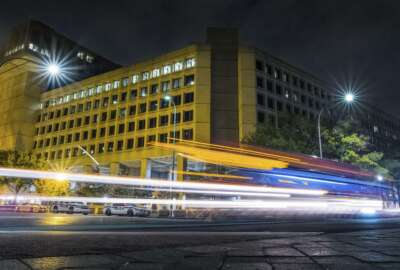New FBI headquarters? Don’t hold your breath
Just because GSA has chosen a site for a new FBI building, doesn't mean anyone should be picking out carpets and drapes just yet.
Finally, a decision on the new FBI headquarters.
But first, federal websites. What’s the connection? Websites, like the J. Edgar Hoover building, require a lot of improvement or else replacement.
That’s a generic statement. In fact, every web site everywhere needs a lot of improvement. The better the website, the better your business’s or your agency’s customer experience. Web sites have in common with buildings the need for perpetual maintenance and improvement. As it grew functionally obsolete, the FBI building in Washington D.C. deteriorated physically. So, too, do websites come to the point of reckoning.
Federal Chief Information Officer Clare Martorana underscored websites and customer experience at ACT-IAC’s big annual conference in Hershey, Pennsylvania. She urged federal tech attendees to get back to the U.S. Web Design System. Hosted for a long time by the General Services Administration, the system states its own purpose right on the home page: “We make it easier to build accessible, mobile-friendly government websites.”
Martorana complained that too few federal sites have been optimized for mobile devices. And, she said, they’ve become fragmented to the point where, at least as some sites, a visitor can’t feel totally assured it’s the legitimate site of the agency.
As someone who visits dozens of federal sites each week, I can confirm they’re not perfect, but they hold their own in the vast sea of websites. A few are stellar.
And yes, while there’s always work to do on a web site, millions of people around the world live under governments that don’t care quite so exquisitely about customer experience.
I’m about to visit a couple of Southeast Asia countries, and I need a visa for one of them. You can only obtain one from the country’s “evisa” site, which looks as if it was designed in 2003 or so. Lots of picky rules about how to upload a picture of your passport, mug shot of yourself and fill in several pages of personal data.
Did I say picky? No less than three times, I received an email that something was wrong. Each time, I’d correct the data field, only to get another email two days later that something else was wrong. Whomever or whatever was looking at the incoming applications seemed to look no further than the first error it encountered, rather than finding all the errors and issuing a single corrective bulletin. Better yet, do what the best contemporary sites do and not even accept the submission until everything is correct.
What should have taken two days extended to two weeks thanks to the crazy serial application examination system. My wife had even more problems, and it looks like we could jet off with only one of us having a visa.
Will they actually build a new FBI headquarters?
Greenbelt, Maryland. The FBI, if it actually moves there, would join NASA Goddard Space Flight Center as a major federal installation. A big IRS center operates out of nearby New Carrolton, Maryland, so it’s not as if Maryland’s Prince George’s County (don’t call it “P-G”) is some sort of federal wasteland. It’s a rather nice area, actually.
The FBI will move there presuming the Virginia congressional delegation doesn’t throw up obstacles. Rep. Gerry Connolly, who’s eternally grumpy in a jovial sort of way, sounded particularly ill-humored after the decision. As Jory Heckman reported, Connolly issued this outburst: “GSA has shamelessly caved to political pressure, putting blatant politics over the merits and amending the weighting of long-established criteria to make this decision all but predictable.”
Politics can be brutal, especially blatant politics.
Connolly added, “GSA’s reputation for objective procurement free from politics has taken a mortal hit today from which it will struggle to recover for years into the future.”
That sounds like some tough hearings and budget fights for years into the future. I’m taking a wild guess, though, that the GSA decision will ultimately stand, if only because people are getting tired of the argument. FBI will likely still have its training operation in Quantico, Virginia. The loss goes to Washington, D.C., and even that’s questionable, given the District’s strong condo and apartment market.
An idea: Replace the FBI building with a smart, good-looking new general purpose office building and move all the agency fragments scattered around D.C. into it.
The decision by GSA only kicks off a long process. Who knows, what if someone discovers a latter-day snail darter in Greenbelt? The environmental donnybrooks would take a decade.
Architectural and other critics have often declared the existing FBI building ugly. In the heart of downtown, it offers a cold shoulder to the public, being essentially a law enforcement headquarters with all the charm typical of police stations. Plus, it’s designed in the – wait for it – Brutalist style, which has earned the “ugly” sobriquet for the Health and Human Services and Housing and Urban Development structures. An earlier column on that prompted a strong response from HHS that, well, they like their building.
If and when its new headquarters is completed, the FBI will certainly occupy a structure totally unlike the one where it now lives. HUD and HHS are going to be in their “ugly” buildings — designed by no less than Marcel Breuer himself — indefinitely.
But old, Brutalist buildings can get new leases on life, no pun intended. I recently visited my collegiate alma mater, the Rochester Institute of Technology. Back when I attended starting in 1973, it occupied about a dozen brick-clad Brutalist buildings constructed all at once in 1966, when the school moved out of downtown Rochester, New York. RIT still called it a new campus.
Now, the building housing, among other things, my photojournalism major is all new, inside. Gone is the ubiquitous smell of sodium hyposulfite, an odor that still provokes fond memories. It looks the same from the outside. But, gutted and redesigned for the digital era, the interior has become more open, airier and better lit than in the 1970s. It features more collaboration areas, outdoor patios, cafe spots and, of course, all of the technology that goes with digital imaging.
As Kamara Jones, HHS acting assistant secretary for public affairs, told me back in August, “If you don’t think the building’s beautiful on the outside, there are a lot of beautiful people and beautiful things happening on the inside.”
The FBI doesn’t call its J. Edgar Hoover headquarters Brutalist. It obliquely refers to the architecture thus: “It echoed a major architectural style of the 1960s.”
By the way, don’t go speculating on adjacent land just yet in Greenbelt. According to the FBI’s own account, the idea for a new FBI headquarters floated in 1939. Congress first appropriated money for design and engineering of the FBI building in 1962.
What happened next? Groundbreaking in 1967, five years later. Then came delays, arguments, strikes and cost overruns. The first cohort of employees moved in during June, 1974 — 12 years later after Congressional approval and 38 years after the idea.
Nearly Useless Factoid
The first two female FBI recruits following J. Edgar Hoover’s ‘no women’ policy were Susan Lynn Roley, a Marine Corps lieutenant, and Joanne Pierce, a former nun.
Source: FBI.gov
Copyright © 2025 Federal News Network. All rights reserved. This website is not intended for users located within the European Economic Area.
Tom Temin is host of the Federal Drive and has been providing insight on federal technology and management issues for more than 30 years.
Follow @tteminWFED







